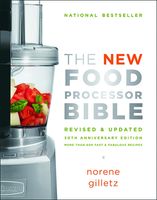Label
All
0
Clear all filters
Prue Leith's latest book is now on ckbk. Get 25% off ckbk Membership
Super Salads and Dressings
Appears in
Published 2011
- Refer to the Smart Chart for basic processing techniques.
- Before processing, wash and dry vegetables well. Peel and core, and remove seeds and any pits to prevent damage to the processor blades.
- See Vegetables and Side Dishes chapter for vegetable processing techniques.
- Vegetables with a high water content (e.g., cucumbers, bell peppers) should be patted dry with paper towels after processing to absorb excess moisture.
- Use a salad spinner to dry salad greens, then wrap in a towel to absorb remaining moisture. Greens can be stored in a resealable plastic bag for a day or 2 in your refrigerator.
- Salad bore or salad bar? There is an amazing selection of fresh produce available today, including local and organic. Much of it is washed, trimmed and ready to serve.
- Take your pick of salad greens! Reach for arugula, Bibb/butterhead, Boston, curly leaf lettuce, endive, escarole, iceberg, romaine, mesclun/mixed salad greens, oak leaf, radicchio, spinach/baby spinach or watercress.
- To give color, texture and flavor to salads, add avocado, broccoli slaw, carrots/baby carrots, red or green cabbage, celery, cucumbers, fennel, bell peppers, onions (Spanish, Vidalia, red), green onions/scallions or chives, and alfalfa, bean or broccoli sprouts.
- Tomatoes are available in many shapes, sizes and colors, from grape tomatoes to beefsteaks to heirlooms. For maximum flavor, store them at room temperature.
- Roasted and grilled vegetables add terrific flavor to salads. Choose from bell peppers, garlic, beets, eggplant, mushrooms or zucchini.
- Lightly steamed broccoli or cauliflower florets, asparagus and green or yellow beans add crunch and flavor to salads.
- Use baked, microwaved or boiled potatoes for potato salad. When cool, remove peel. (New potatoes do not need to be peeled.) Slice or cut into cubes by hand; potatoes may crumble if sliced on the processor.
- Jarred or canned marinated artichoke hearts, olives, sun-dried tomatoes, roasted bell peppers, canned beets, kidney beans, black beans, chickpeas, lentils or corn niblets add variety with no fuss or muss.
- Use pasta, rice, bulgur, couscous, quinoa, barley, kasha or other cooked grains for a hearty salad base.
- Add color, zing and nutrients to salads with fresh fruit. Dried fruits (e.g., apricots, cranberries, raisins) make a quick, delicious addition. Pomegranate seeds are beautiful as a garnish!
- Finish off your salads with toasted sunflower seeds, sesame seeds, almonds, walnuts, flax seed, wheat germ, croutons or chow mein noodles.
- Try adding cheddar, Swiss, mozzarella, Muenster or Parmesan, crumbled feta, goat or cottage cheese to salads for flavor and extra protein.
- Add cooked chicken, turkey, cold cuts, hard-cooked egg wedges, cooked or canned fish (e.g., salmon, tuna) for hearty main-dish salads. Allow 1 to 2 cups salad per person as a main dish.
- Use the Steel Blade to make salad dressings. Transform dips into dressings by thinning them down with a little milk or buttermilk.
- For small quantities of salad dressings and marinades, use a mini-prep. If your processor comes with nested bowls, use the mini-bowl and mini-blade for small amounts.
- Replace part of the oil in salad dressings with fruit juice, or chicken or vegetable broth. Experi-ment with different vinegars (balsamic, cider, rice or wine vinegar) and fruit juices (lemon, lime, grapefruit, mango or orange juice). For variety, use extra-virgin olive oil, toasted sesame oil or walnut oil.
- Add salad dressing to salads just before serving; otherwise salad will become limp and watery.
- INSTANT GAZPACHO! Transform limp, leftover salad into delicious soup. Process on the Steel Blade until finely chopped. Combine with tomato or vegetable juice and a squeeze of fresh lemon juice. Season to taste. Serve chilled. Garnish with chopped tomatoes, bell peppers and green onions.
- NESTED BOWL METHOD: Choose the appropriate bowl and blade or disc for the task. Use the small bowl to mince garlic or herbs for salad dressings or for other small tasks. Use the medium or large bowl and appropriate disc to slice or shred/grate veggies, cheese, etc. Use the large bowl and Steel Blade to chop/mince vegetables and to combine ingredients.
- To shred leafy vegetables like lettuce or spinach for salads, roll leaves together and stand them up in the feed tube. Process using medium pressure.
Become a Premium Member to access this page
Unlimited, ad-free access to hundreds of the world’s best cookbooks
Over 150,000 recipes with thousands more added every month
Recommended by leading chefs and food writers
Powerful search filters to match your tastes
Create collections and add reviews or private notes to any recipe
Swipe to browse each cookbook from cover-to-cover
Manage your subscription via the My Membership page
Best value
In this section
Advertisement
Advertisement
The licensor does not allow printing of this title


